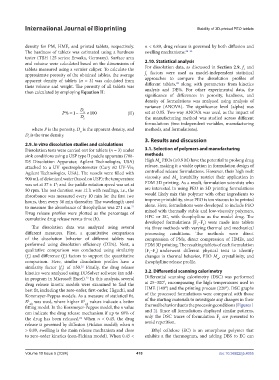Page 418 - IJB-10-5
P. 418
International Journal of Bioprinting Stability of 3D-printed PEO tablets
density for PM, HME, and printed tablets, respectively. n < 0.89, drug release is governed by both diffusion and
The hardness of tablets was estimated using a hardness swelling mechanisms. 24–26
tester (TBH 125 series; Erwaka, Germany). Surface area
and volume were calculated based on the dimensions of 2.10. Statistical analysis
tablets measured using a vernier caliper. To calculate the For dissolution data, as discussed in Section 2.9, f and
2
approximate porosity of the obtained tablets, the average f factors were used as model-independent statistical
1
apparent density of tablets (n = 3) was calculated from approaches to compare the dissolution profiles of
22
their volume and weight. The porosity of all tablets was different tablets, along with parameters from kinetics
then calculated by employing Equation II: analysis and DE%. For other experimental data, the
significance of differences in porosity, hardness, and
density of formulations was analyzed using analysis of
variance (ANOVA). The significance level (alpha) was
D
P% =−1 a ×100 (II) set at 0.05. Two-way ANOVA was used, as the impact of
D t the manufacturing method was studied across different
formulations (two independent variables, manufacturing
where P is the porosity, D is the apparent density, and methods, and formulations).
a
D is the true density.
t 3. Results and discussion
2.9. In vitro dissolution studies and calculations
Dissolution tests were carried out for tablets (n = 3) under 3.1. Selection of polymers and manufacturing
sink conditions using a USP type II paddle apparatus (708- methods
DS Dissolution Apparatus; Agilent Technologies, USA) High M PEOs (≥0.9 M) have the potential to prolong drug
w
attached to a UV spectrophotometer (Cary 60 UV-Vis; release, making it a viable option in formulation design of
Agilent Technologies, USA). The vessels were filled with controlled release formulations. However, their high melt
900 mL of deionized water (based on USP); the temperature viscosity and M instability restrict their application in
w
was set at 37 ± 1°; and the paddle rotation speed was set at FDM 3D printing. As a result, formulation scientists who
50 rpm. The test duration was 12 h with readings, i.e., the are interested in using PEO in 3D printing formulations
absorbance was measured every 10 min for the first two would likely mix this polymer with other ingredients to
hours, then every 30 min thereafter. The wavelength used improve printability, since PEO is too viscous to be printed
to measure the absorbance of theophylline was 271 nm. alone. Here, formulations were developed to include PEO
21
Drug release profiles were plotted as the percentage of mixed with thermally stable and low-viscosity polymers,
cumulative drug release versus time (h). HPC or EC, with theophylline as the model drug. The
developed formulations (F –F ) were made into tablets
1
4
The dissolution data was analyzed using several via three methods with varying thermal and mechanical
different measures. First, a quantitative comparison processing conditions. The methods were direct
of the dissolution behavior of different tablets was compression of PMs, direct compression of HMEs, and
performed using dissolution efficiency (DE%). Next, a FDM 3D printing. The resulting tablets of each formulation
qualitative comparison was conducted using similarity (F –F ) underwent different physical tests to identify
4
1
(f ) and difference (f ) factors to support the quantitative changes in thermal behavior, PEO M , crystallinity, and
1
2
w
comparison. Here, similar dissolution profiles have a theophylline release profile.
similarity factor (f ) of ≥50. Finally, the drug release
22
2
kinetics were analyzed using DDSolver software (an add- 3.2. Differential scanning calorimetry
23
in program in Microsoft Excel). In this analysis, several Differential scanning calorimetry (DSC) was performed
drug release kinetic models were examined to find the at 25–300°, encompassing the high temperatures used in
best fit, including the zero-order, first-order, Higuchi, and HME (140°) and the printing process (220°). DSC graphs
Korsmeyer-Peppas models. As a measure of statistical fit, of the processed formulations were compared with those
R was used, where higher R values indicate a better of the starting materials to investigate any changes in their
2
2
adj
adj
fitting model. In the Korsmeyer-Peppas model, the n value thermal behavior due to the processing conditions (Figures 1
can indicate the drug release mechanism if up to 60% of and 2). Since all formulations displayed similar patterns,
the drug has been released. When n < 0.45, the drug only the DSC traces of formulation F are presented to
24
2
release is governed by diffusion (Fickian model); when n avoid repetition.
> 0.89, swelling is the main release mechanism and close Ethyl cellulose (EC) is an amorphous polymer that
to zero-order kinetics (non-Fickian model). When 0.45 < exhibits a flat thermogram, and adding DBS to EC can
Volume 10 Issue 5 (2024) 410 doi: 10.36922/ijb.4055

